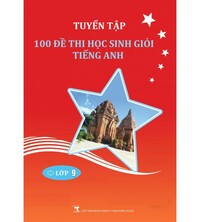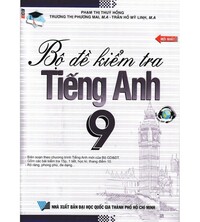Reading - Unit 4. Remembering the past - SBT Tiếng Anh 9 Global Success
1. Choose the correct option A, B, C, or D to fill in each blank in the following passage.2. Read the passage and choose the best answer A, B, C, or D to each of the questions. 3. Fill in each blank with a word to complete the passage.
Bài 1
1. Choose the correct option A, B, C, or D to fill in each blank in the following passage.
(Chọn phương án đúng A, B, C hoặc D để điền vào chỗ trống trong đoạn văn sau.)
ONE-ROOM SCHOOLHOUSES
In the 1800s and early 1900s, most children went to school in one-room schoolhouses. At that time, most people lived (1) _____ farms. The farms were spread out. One-room schoolhouses were built because there weren’t many children in the farm areas. Most of the one-room schoolhouses only (2) _____ about fifteen to twenty children. The one-room schoolhouses had just one teacher. That teacher instructed all students from the age of five or six up to ages thirteen or fourteen or even older. The teacher also (3) _____ all subjects. In one-room schoolhouses, students did a lot of reciting and memorising. Reciting means that they said out loud (4) _____ they learned. The teacher would ask a question, and the students would stand up and recite the answer. Students also did a lot of memorising. They were often asked to memorise poems. They had to memorise famous (5) _____ and important facts, too.
1. A. in B. on C. for D. with
2. A. had B. made C. founded D. promoted
3. A. gave B. observed C. taught D. educated
4. A. which B. how C. that D. what
5. A. speeches B. words C. languages D. questions
Lời giải chi tiết:

1. B
A. in (prep): trong
B. on (prep): trên => cụm: on a farm: ở trang trại
C. for (prep): cho
D. with (prep): với
At that time, most people lived on farms.
(Vào thời điểm đó, hầu hết mọi người sống ở trang trại.)
2. A
A. had (V_ed): có
B. made (V_ed): tạo ra, làm ra
C. founded (V_ed): thành lập
D. promoted (V_ed): thúc đẩy
Most of the one-room schoolhouses only had about fifteen to twenty children.
(Hầu hết các ngôi trường một phòng chỉ có khoảng mười lăm đến hai mươi học sinh.)
3. C
A. gave (V_ed): trao, tặng
B. observed (V_ed): quan sát
C. taught (V_ed): dạy
D. educated (V_ed): giáo dục
The teacher also taught all subjects.
(Người giáo viên đó còn dạy tất cả các môn.)
4. D
A. which: cái nào (hỏi lựa chọn)
B. how: như thế nào
C. that: rằng
D. what: cái gì
Reciting means that they said out loud what they learned.
(Đọc thuộc lòng có nghĩa là họ nói to những gì họ đã học.)
5. A
A. speeches (n): bài phát biểu
B. words (n): từ
C. languages (n): ngôn ngữ
D. questions (n): câu hỏi
They had to memorise famous speeches and important facts, too.
(Họ cũng phải ghi nhớ những bài phát biểu nổi tiếng và những sự kiện quan trọng.)
Bài đọc hoàn chỉnh:
ONE-ROOM SCHOOLHOUSES
In the 1800s and early 1900s, most children went to school in one-room schoolhouses. At that time, most people lived on farms. The farms were spread out. One-room schoolhouses were built because there weren’t many children in the farm areas. Most of the one-room schoolhouses only had about fifteen to twenty children. The one-room schoolhouses had just one teacher. That teacher instructed all students from the age of five or six up to ages thirteen or fourteen or even older. The teacher also taught all subjects. In one-room schoolhouses, students did a lot of reciting and memorising. Reciting means that they said out loud what they learned. The teacher would ask a question, and the students would stand up and recite the answer. Students also did a lot of memorising. They were often asked to memorise poems. They had to memorise famous speeches and important facts, too.
Tạm dịch bài đọc:
NHỮNG NGÔI TRƯỜNG MỘT PHÒNG
Vào những năm 1800 và đầu những năm 1900, hầu hết trẻ em đến trường trong những ngôi trường một phòng. Vào thời điểm đó, hầu hết mọi người sống ở trang trại. Các trang trại lan rộng ra. Những ngôi trường một phòng được xây dựng vì ở vùng nông thôn không có nhiều trẻ em. Hầu hết các ngôi trường một phòng chỉ có khoảng mười lăm đến hai mươi học sinh. Những ngôi trường một phòng chỉ có một giáo viên. Giáo viên đó đã dạy tất cả học sinh từ năm, sáu tuổi cho đến mười ba, mười bốn tuổi hoặc thậm chí lớn hơn. Người giáo viên đó còn dạy tất cả các môn. Trong những ngôi trường một phòng, học sinh đọc thuộc lòng và ghi nhớ rất nhiều. Đọc thuộc lòng có nghĩa là họ nói to những gì họ đã học. Giáo viên đặt câu hỏi, học sinh đứng lên đọc đáp án. Học sinh cũng đã ghi nhớ rất nhiều. Họ thường được yêu cầu ghi nhớ những bài thơ. Họ cũng phải ghi nhớ những bài phát biểu nổi tiếng và những sự kiện quan trọng.
Bài 2
2. Read the passage and choose the best answer A, B, C, or D to each of the questions.
(Đọc đoạn văn và chọn câu trả lời đúng A, B, C hoặc D cho mỗi câu hỏi.)
Edinburgh is the capital city of Scotland. It has enormous historical significance. Located on the east coast of Scotland, Edinburgh proudly offers a window to the past. For many people, this city is an exciting mix of something traditional and something modern.
Edinburgh has been Scotland’s royal city since 1437. Most of Edinburgh’s sights are within two districts: the old town and the new town. The medieval Royal Mile stretching for over a mile from Edinburgh Castle to the Palace of Holyroodhouse dominates the city’s central area. The Royal Mile is one of the largest, longest and most splendid streets for buildings in Britain.
To millions of visitors, Edinburgh Castle is a must-see because there are many treasures. Princess Street is in Edinburgh’s new town, directly below the castle. Next to Princess Street, in the shadow of Edinburgh Castle, lies the green Princess Street Gardens. This is one of the most delightful gardens in Britain. Edinburgh is also a cultural centre. The worldwide famous Edinburgh Fringe Festival (a series of arts festivals held in August) draws thousands and thousands of visitors to the city annually. So Edinburgh is really a place no traveler should ignore.
Tạm dịch bài đọc:
Edinburgh là thủ đô của Scotland. Nó có ý nghĩa lịch sử to lớn. Nằm trên bờ biển phía đông của Scotland, Edinburgh tự hào mang đến một cánh cửa nhìn về quá khứ. Đối với nhiều người, thành phố này là sự kết hợp thú vị giữa nét truyền thống và nét hiện đại.
Edinburgh đã là thành phố hoàng gia của Scotland từ năm 1437. Hầu hết các điểm tham quan của Edinburgh đều nằm trong hai quận: khu phố cổ và thị trấn mới. Royal Mile thời trung cổ trải dài hơn một dặm từ Lâu đài Edinburgh đến Cung điện Holyroodhouse chiếm ưu thế ở khu vực trung tâm thành phố. Royal Mile là một trong những con đường lớn nhất, dài nhất và lộng lẫy nhất dành cho các tòa nhà ở Anh.
Đối với hàng triệu du khách, Lâu đài Edinburgh là địa điểm không thể bỏ qua vì có rất nhiều kho báu. Phố Princess nằm ở thị trấn mới của Edinburgh, ngay bên dưới lâu đài. Bên cạnh Phố Princess, dưới bóng của Lâu đài Edinburgh, là Khu vườn Phố Princess xanh tươi. Đây là một trong những khu vườn thú vị nhất ở Anh. Edinburgh cũng là một trung tâm văn hóa. Lễ hội Edinburgh Fringe nổi tiếng thế giới (một chuỗi lễ hội nghệ thuật được tổ chức vào tháng 8) thu hút hàng nghìn du khách đến thành phố hàng năm. Vì thế Edinburgh thực sự là nơi mà du khách không nên bỏ qua.
1. Which of the following dominates the central area of Edinburgh?
A. The Royal Mile.
B. Edinburgh Castle.
C. Holyroodhouse.
D. Princess Street.
2. The word “splendid” in the passage mostly means _____.
A. communal
B. basic
C. magnificent
D. occupied
3. The word “This” in the passage refers to _____.
A. Princess Street
B. Edinburgh
C. Edinburgh Castle
D. Princess Street Gardens
4. Which of the following is NOT true, according to the passage?
A. Edinburgh belonged to the past.
B. Edinburgh is Scotland’s royal city.
C. Holyroodhouse is at one end of Royal Mile.
D. Arts festivals are held in August in Edinburgh.
5. Where can you find this passage?
A. In a local guide book.
B. In a travel journal.
C. In a student’s diary.
D. In a science report.
Lời giải chi tiết:

1. A
Cái nào sau đây chiếm ưu thế ở khu vực trung tâm của Edinburgh?
A. The Royal Mile.
B. Lâu đài Edinburgh.
C. Holyroodhouse.
D. Phố Princess.
Thông tin: The medieval Royal Mile stretching for over a mile from Edinburgh Castle to the Palace of Holyroodhouse dominates the city’s central area.
(Royal Mile thời trung cổ trải dài hơn một dặm từ Lâu đài Edinburgh đến Cung điện Holyroodhouse chiếm ưu thế ở khu vực trung tâm thành phố.)
Chọn A
2. C
Từ “splendid” trong đoạn văn chủ yếu có nghĩa là _____.
splendid (adj): lộng lẫy, tráng lệ
A. communal (adj): cộng đồng
B. basic (adj): cơ bản
C. magnificent (adj): tráng lệ
D. occupied (adj): chiếm đóng, bận rộn
=> splendid = magnificent: tráng lệ
Chọn C
3. D
Từ “This” trong đoạn văn đề cập đến _____.
A. Phố Princess
B. Edinburgh
C. Lâu đài Edinburgh
D. Khu vườn Phố Princess
Thông tin: Next to Princess Street, in the shadow of Edinburgh Castle, lies the green Princess Street Gardens. This is one of the most delightful gardens in Britain.
(Bên cạnh Phố Princess, dưới bóng của Lâu đài Edinburgh, là Khu vườn Phố Princess xanh tươi. Đây là một trong những khu vườn thú vị nhất ở Anh.)
Chọn D
4. A
Theo đoạn văn điều nào sau đây KHÔNG đúng?
A. Edinburgh đã thuộc về quá khứ.
B. Edinburgh là thành phố hoàng gia của Scotland.
C. Holyroodhouse nằm ở một đầu của Royal Mile.
D. Những lễ hội nghệ thuật được tổ chức vào tháng 8 ở Edinburgh.
Thông tin: Located on the east coast of Scotland, Edinburgh proudly offers a window to the past. For many people, this city is an exciting mix of something traditional and something modern.
(Nằm trên bờ biển phía đông của Scotland, Edinburgh tự hào mang đến một cánh cửa nhìn về quá khứ. Đối với nhiều người, thành phố này là sự kết hợp thú vị giữa nét truyền thống và nét hiện đại.)
Chọn A
5. A
Bạn có thể tìm thấy đoạn văn này ở đâu?
A. Trong sách hướng dẫn địa phương.
B. Trong một tạp chí du lịch.
C. Trong nhật ký của một học sinh.
D. Trong một báo cáo khoa học.
Đoạn văn đưa ra thông tin về các địa điểm nổi tiếng ở Edinburgh cho du khách biết thông tin
Chọn A
Bài 3
3. Fill in each blank with a word to complete the passage.
(Điền vào mỗi chỗ trống một từ để hoàn thành đoạn văn.)
The One Pillar Pagoda is a historic Buddhist temple in Ha Noi. The unique pagoda is (1) _____ in the western part of the city, near Ho Chi Minh’s Mausoleum. Legend has it that Emperor Ly Thai To of the Ly Dynasty, who had no children, used to go to (2) _____ to pray to Buddha for a son. One night, he dreamt that he met a man, who (3) _____ sitting on a great lotus flower in a square-shaped pond on the western side of Thang Long Citadel. This man gave the King a baby boy. Months later, (4) _____ the Queen gave birth to a boy, the Emperor ordered the construction of a pagoda supported by only one (5) _____ to look like the lotus seat in his dream. According to a theory, the pagoda was built in a style of a lotus emerging out of the water.
Lời giải chi tiết:

1. located
Cấu trúc: be located: ở tại
The unique pagoda is located in the western part of the city, near Ho Chi Minh’s Mausoleum.
(Ngôi chùa độc đáo nằm ở phía Tây thành phố, gần Lăng Chủ tịch Hồ Chí Minh.)
2. pagodas
pagoda (n): ngôi chùa => số nhiều: pagodas
Legend has it that Emperor Ly Thai To of the Ly Dynasty, who had no children, used to go to pagodas to pray to Buddha for a son.
(Tương truyền, vua Lý Thái Tổ nhà Lý vốn không có con nên thường vào chùa cầu Phật sinh con.)
3. was
Thì quá khứ tiếp diễn: S + was/ were + V_ing
Diễn tả 1 hành động đang xảy ra tại 1 thời điểm trong quá khứ
One night, he dreamt that he met a man, who was sitting on a great lotus flower in a square-shaped pond on the western side of Thang Long Citadel.
(Một đêm nọ, ông nằm mơ thấy mình gặp một người đàn ông đang ngồi trên bông sen lớn trong một cái ao hình vuông ở phía Tây Hoàng thành Thăng Long.)
4. when
when: khi
Months later, when the Queen gave birth to a boy, the Emperor ordered the construction of a pagoda …
(Nhiều tháng sau, khi Hoàng hậu hạ sinh một bé trai, Hoàng đế ra lệnh xây dựng một ngôi chùa …)
5. pillar
pillar (n): cột
Months later, when the Queen gave birth to a boy, the Emperor ordered the construction of a pagoda supported by only one pillar to look like the lotus seat in his dream.
(Nhiều tháng sau, khi Hoàng hậu hạ sinh một bé trai, Hoàng đế ra lệnh xây dựng một ngôi chùa chỉ có một cây cột chống đỡ trông giống như tòa sen trong giấc mơ của ông.)
Đoạn văn hoàn chỉnh:
The One Pillar Pagoda is a historic Buddhist temple in Ha Noi. The unique pagoda is located in the western part of the city, near Ho Chi Minh’s Mausoleum. Legend has it that Emperor Ly Thai To of the Ly Dynasty, who had no children, used to go to pagodas to pray to Buddha for a son. One night, he dreamt that he met a man, who was sitting on a great lotus flower in a square-shaped pond on the western side of Thang Long Citadel. This man gave the King a baby boy. Months later, when the Queen gave birth to a boy, the Emperor ordered the construction of a pagoda supported by only one pillar to look like the lotus seat in his dream. According to a theory, the pagoda was built in a style of a lotus emerging out of the water.
Tạm dịch bài đọc:
Chùa Một Cột là một ngôi chùa Phật giáo lịch sử ở Hà Nội. Ngôi chùa độc đáo nằm ở phía Tây thành phố, gần Lăng Chủ tịch Hồ Chí Minh. Tương truyền, vua Lý Thái Tổ nhà Lý vốn không có con nên thường vào chùa cầu Phật sinh con. Một đêm nọ, ông nằm mơ thấy mình gặp một người đàn ông đang ngồi trên bông sen lớn trong một cái ao hình vuông ở phía Tây Hoàng thành Thăng Long. Người đàn ông này đã trao cho nhà vua một bé trai. Nhiều tháng sau, khi Hoàng hậu hạ sinh một bé trai, Hoàng đế ra lệnh xây dựng một ngôi chùa chỉ có một cây cột chống đỡ trông giống như tòa sen trong giấc mơ của ông. Theo giả thuyết, chùa được xây dựng theo kiểu hoa sen nhô lên khỏi mặt nước.
Search google: "từ khóa + timdapan.com" Ví dụ: "Reading - Unit 4. Remembering the past - SBT Tiếng Anh 9 Global Success timdapan.com"







